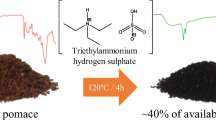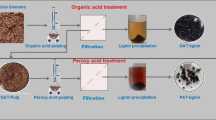Abstract
Lignin quantification in apple pomace residues was carried out using a microwave oven to replace traditional refluxing during the mild acidolysis step to augment the selectivity of this step towards cleavage of lignin–carbohydrate bonds and to reduce the time needed to quantify lignin. The pressure, temperature and time were optimized by response surface methodology and the results were compared to the Klason lignin methodology. Temperature and pressure had a significant positive effect (p < 0.05) on the determination of lignin. However, the time was also significant (p < 0.05) on lignin quantification. The optimal conditions of digestion were: 30 bar, 170 °C for 15 min. The digestion using microwave (lignin content = 33 % w/w) was more accurate (p < 0.05) than the the traditional refluxing (lignin content = 27 % w/w).



Similar content being viewed by others
References
Alves MA, Schwanninger M, Pereira H, Rodrigues J et al (2009) Analytical pyrolysis as a direct method to determine the lignin content in wood. Part 3. Evaluation of species specific and tissue-specific differences in softwood lignin composition using principal component analysis. J Anal Appl Pyrolysis 85:30–37
Dallinger D, Kappe CO (2007) Microwave-assisted synthesis in water as solvent. Chem Rev 107:2563–2591
De la Hoz A, Diaz-Ortiz A, Moreno A et al (2005) Microwaves in organic synthesis. Thermal and non-thermal microwave effects. Chem Soc Rev 34:164–178
Fengel D, Wegener G (eds) (1989) Wood chemistry ultrastructure and reactions. de Gruyter, Berlin, p 613
Gassara F, Brar SK, Pelletier F, Verma M, Godbout S, Tyagi RD et al (2011) Pomace waste management scenarios in Québec—impact on greenhouse gas emissions. J Hazard Mater. doi:10.1016/j.jhazmat
Guerra A, Filpponen I, Lucia LA, Saquing C, Baumberger S, Argyropoulos DS et al (2006) Toward a better understanding of the lignin isolation process from wood. J Agric Food Chem 54:5939–5947
Hatfield RD, Jung HG, Ralph J, Buxton DR, Weimer PJA (1994) Comparison of the insoluble residues produced by the Klason lignin and acid detergent lignin procedures. J Sci Food Agric 65:51–58
Kirk TK, Obst JR (1988) Lignin determination. Meth Enzymol 161:89–101
Lai YZ, Sarkanen KV (1971) Isolation and structural studies. In: Sarkanen KV, Ludwig CH (eds) Lignins, occurrence, formation, structure and reactions. Wiley Interscience, New York, pp 165–240
Lawoko M, Henriksson G, Gellerstedt G et al (2006) Characterization of lignin–carbohydrate complexes from spruce sulfite pulps. Holzforschung 60:162–165
Lindstrom P, Tierney J, Wathey B, Westman J et al (2001) Microwave assisted organic synthesis—a review. Tetrahedron 57:9225–9283
Singh SK, Dodge J, Durrani MJ, Khan MA (1995) Optimization and characterization of controlled release pellets coated with experimental latex: I. Anionic drug. Int J Pharm 125:243–255
Theander O, Westerlund EA (1986) Studies on dietary fiber. 3. Improved procedures for analysis of dietary fiber. J Agric Food Chem 34:330–336
Van Soest PJ (1967) Development of a comprehensive system of feed analysis and its application to forages. J Anim Sci 26:119–128
Vendruscolo F, Albuquerque PM, Streit F et al (2008) Apple pomace: a versatile substrate for biotechnological applications. Crit Rev Biotechnol 28:1–12
Villas-Bôas SG, Esposito E, Mendonça MM (2002) The novel lignocellulolytic ability of Candida utilis during solid-substrate cultivation on apple pomace. World J Microbiol Biotechnol 18(6):541–545
Zoia L, Orlandi M, Argyropoulo DS (2008) Microwave-assisted lignin isolation using the enzymatic mild acidolysis (EMAL) protocol. J Agric Food Chem 56:10115–10122
Acknowledgments
The authors thank to the Natural Sciences and Engineering Research Council of Canada, FQRNT (ENC 125216) MAPAQ (No. 809051) and Projet Initiative Inde 2010 for financial support. The views or opinions expressed in this article are those of the authors.
Author information
Authors and Affiliations
Corresponding author
Rights and permissions
About this article
Cite this article
Gassara, F., Ajila, C.M., Brar, S.K. et al. Lignin analysis using microwave digestion. Biotechnol Lett 34, 1811–1815 (2012). https://doi.org/10.1007/s10529-012-0991-7
Received:
Accepted:
Published:
Issue Date:
DOI: https://doi.org/10.1007/s10529-012-0991-7




